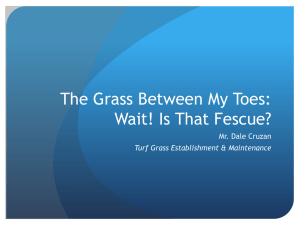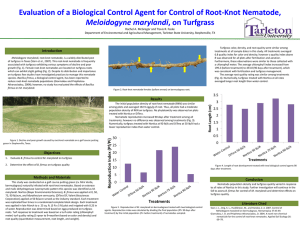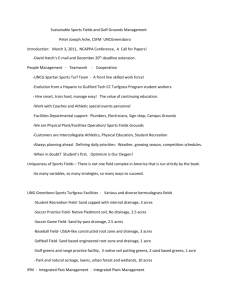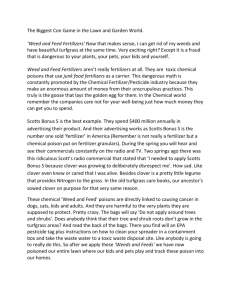7573784_0000001 - Proposal Project Management System
advertisement
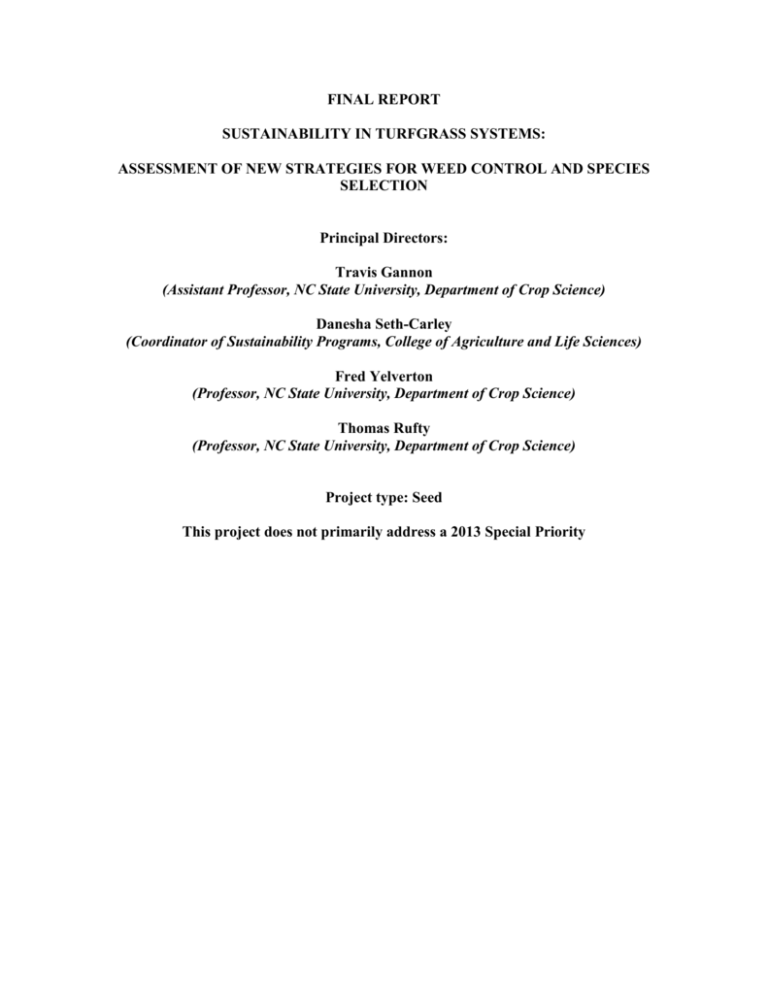
FINAL REPORT SUSTAINABILITY IN TURFGRASS SYSTEMS: ASSESSMENT OF NEW STRATEGIES FOR WEED CONTROL AND SPECIES SELECTION Principal Directors: Travis Gannon (Assistant Professor, NC State University, Department of Crop Science) Danesha Seth-Carley (Coordinator of Sustainability Programs, College of Agriculture and Life Sciences) Fred Yelverton (Professor, NC State University, Department of Crop Science) Thomas Rufty (Professor, NC State University, Department of Crop Science) Project type: Seed This project does not primarily address a 2013 Special Priority Turfgrasses are one of the most important agricultural commodities in the southeast United States. By the traditional measures of economic impact and total acreage, they rank among the leading agricultural crops in most southeastern states. As the base for recreational facilities like parks, athletic fields, and home lawn play spaces, turfgrasses provide the infrastructure for increasing physical activity - now imperative with the national initiatives to control obesity. Although weed, pathogen, and insect management in turfgrass systems leads to frequent pesticide applications, herbicides are the most common intervention. Some of the pesticides that are used have been linked with harmful effects on human health and water quality. Turfgrasses are typically a monoculture that must grow aggressively to maintain density and durability under intense physical activity. The intensive management in these systems, as in traditional agricultural systems, presents risks associated with chemical application. In this research, we investigated the first phase of a comprehensive research program to develop new integrated pest management (IPM) strategies for pest control in turfgrass systems that will minimize or eliminate the health and environmental problems posed by pesticide use. The initial focus is developing strategies that reduce synthetic pesticide inputs for weed management, one of the most difficult challenges for an effective IPM program in turfgrass systems. The effectiveness of non-pesticide weed-control treatments were evaluated alone and compared to synthetic herbicides. The focus was on new, recently registered herbicides that have improved modes of action and very low use rate herbicides. The effect of turfgrass mowing heights was also evaluated as well as comparing native and non-native turfgrass species. Field plots were located at the Lake Wheeler Turfgrass Field Laboratory, and the Horticultural Field Laboratory at N.C. State. These research facilities are located in the ‘transition zone’ for turfgrasses, so they are well situated for extensive turfgrass research. Because weed control is the most difficult hurdle for an effective IPM program, results gathered in this research will provide the base information substantiating that alternative approaches to pest control are workable in turfgrass systems. Further, these data will be utilized to accomplish the goals of the National IPM Roadmap by offering new IPM strategies to turf managers and other stakeholders and help to increase adoption rates of these strategies. Objectives 1. Evaluate the efficacy of alternative “pesticide-free” and reduced pesticide input strategies for weed control in recreational turfgrass systems. Treatments with partial and total replacement of synthetic pesticides will be compared to traditional, widely-used synthetic herbicides that may pose a threat to human health and the environment. The treatment comparisons will include new synthetic herbicides with lower application rates that may pose a lower risk (Table 1). The research will be conducted with warm- and cool-season grasses commonly grown in the Southeast and will include conditions simulating highly managed and residential turfgrass systems. 2. Determine the effect of turfgrass mowing height on weed populations and herbicide efficacy to determine if reduced application rates may provide acceptable results. Turfgrass will be managed at different mowing heights to determine if reduced herbicide rates may be utilized under varying mowing heights without compromising weed control. Previous research suggests weed incidence may be affected by turfgrass mowing height in the southeastern U.S. These mowing heights and weed infestation incidence will be tested against other published recommendations for both cool- and warm-season turfgrasses. 3. Evaluate various native turfgrass species for survivability and performance in the transition zone with reduced inputs. Alternative pest management programs (organic and conventional) will also be evaluated. Native turfgrass species will be established and evaluated under reduced or minimal inputs to determine if they represent a viable option in the transition zone. These species will be compared to commonly used non-native species. Procedures Objective 1. Plots will be located in established turf-type tall fescue (Festuca arundinacea) or bermudagrass (Cynodon dactylon) at the Lake Wheeler Turfgrass Research Laboratory. Plots will be established in turfgrass areas with natural crabgrass (Digitaria spp.) or goosegrass (Eleusine indica) infestations simulating home lawns, athletic fields, parks, golf courses, etc. Evaluated treatments will include: traditional synthetic preemergence herbicides pendimethalin and prodiamine [0.75 – 3 lb active ingredient (ai) per acre], a recentlyregistered preemergence herbicide, indaziflam, (0.1 lb ai per acre), a pesticide-free product mix, and combinations of the pesticide-free mix with the new synthetic herbicide at lowered rates. As indicated, the traditional synthetic herbicides are applied at higher use rates (greater ai), and their efficacy has not been compared to the recently-registered herbicide which has a lower use rate, and certainly not when the new herbicide is applied at lower than labeled rates. The pesticide-free weed control mix will include corn gluten and recaptured carbon dioxide applied in spot sprays. The recaptured carbon dioxide component is a new method of organic weed control that utilizes applications of liquid carbon dioxide that quickly converts to frost when expelled. Treatment list: 1. Nontreated 2. Organic/alternative approach a. Corn gluten b. Recaptured liquid carbon dioxide 3. Organic approach supplemented with synthetic herbicide a. Corn gluten + indaziflam (0.25 X rate) b. Corn gluten + indaziflam (0.5 X rate) c. Corn gluten + indaziflam (1 X rate) 4. Traditional synthetic herbicides – higher labeled use rate a. Prodiamine b. Pendimethalin 5. Recently-registered herbicides – lower labeled use rate Indaziflam Objective 2. Research will be initiated in established turf-type tall fescue (Festuca arundinacea) or bermudagrass (Cynodon dactylon) at the Lake Wheeler Turfgrass Research Laboratory. Plots will be established in turfgrass areas with natural weed infestations to evaluate preemergence herbicide efficacy as affected by turfgrass mowing height. Evaluated treatments will include: traditional synthetic preemergence herbicides dithiopyr, oxadiazon, pendimethalin and prodiamine [0.5 – 3 lb active ingredient (ai) per acre] as well as a recently-registered preemergence herbicide, indaziflam, (0.1 lb ai per acre). Each herbicide will be evaluated under at least two mowing heights to compare efficacy as affected by mowing height which has not previously been conducted. Treatment levels: 1. Synthetic herbicides a. Dithiopyr (0.25 or 0.5 lb ai) b. Indaziflam (0.05 or 0.1 lb ai) c. Oxadiazon (1.5 or 3 lb ai) d. Pendimethalin (1.5 or 3 lb ai) e. Prodiamine (0.5 or 1 lb ai) f. Nontreated 2. Mowing heights a. 0.5” b. 2” Objective 3. Research will be initiated at the Horticultural Field Laboratory in Raleigh, NC. There will be four replications of plots measuring approximately 20’x 40’ (each turfgrass species will be 10’ x 20’ with a 1’ space separating each). Treatment levels: 1. Native turfgrass species a. Bouteloua gracilis (sideoats grama) b. Danthonia spicata (poverty oatgrass) 2. Non-native turfgrass species a. Cynodon dactylon (bermudagrass) b. Festuca arundinacea (tall fescue) 3. Pest management programs a. Bayer Natria Grass and Weed Killer and Bayer Natria Disease Control b. Earthworm Castings from Circle Organics Scott’s synthetic fertilizer and pesticide products per recommended program During June, 2013, tall fescue and bermudagrass were planted in the form of sod, and side oats grama and poverty oatgrass were planted as plugs 6” apart. Each plot area is approximately 25 sq ft. Treatments are as follows: Scott’s Annual Lawn Care Program o Four step program including weed and feed applications in spring, early summer, late summer/early fall, and late fall; rates applied per label specifications Circle Organics Lawn Care Program o Four step program including initial inoculation of mycorrhizae at planting, monthly applications of Eco-Boost, and bi-monthly applications of organic turf fertilizer; rates applied per label specifications and manufacturer recommendations Natria Herbicide Program o Monthly applications of post-emergent contact herbicide for weeds in the turfgrasses; rates applied per label specifications Espoma Annual Lawn Care Program o Weed and feed program including applications of organic fertilizer in spring, summer, and fall with monthly post-emergent contact herbicide applications; rates applied per label specifications Plots are mowed weekly during the growing season. Visual observations are made weekly. Chlorophyll, brightness, and weed count data are collected monthly during the growing season. Irrigation is applied at 1” per week for half the plots and natural precipitation for the other half. If there is not any rainfall recorded, then no more than ¼” additional irrigation is applied to the turfgrasses receiving natural precipitation. Results and Discussion In established bermudagrass turf, treatments that did not include a synthetic herbicide did not provide acceptable weed control through 16 weeks after treatment while label rates of commercially available products provided complete crabgrass control (Tables 1, 2, and 3). Full label application rates of Barricade (prodiamine) and Dimension (dithiopyr) provided acceptable crabgrass control regardless of tall fescue mowing height (Table 4). However, Pendulum (pendimethalin) provided greater control at the higher mowing height. Utilizing split applications, Barricade provided complete control regardless of the mowing height; however, split applications of Dimension and Pendulum provided less control at the lower mowing height. Full label application rates of Barricade (prodiamine), Dimension (dithiopyr), Specticle (indaziflam), Ronstar (oxadiazon), and Echelon (prodiamine + sulfentrazone) provided acceptable crabgrass control in established bermudagrass (Table 5). The grasses that were planted by plugs, poverty oatgrass and side oats grama, are demonstrating high weed counts due to more soil being exposed. The grasses planted by sod, tall fescue and bermudagrass, are showing little to no weeds, usually no more than three or four weeds if any are present. The poverty oatgrass has not shown capacity to outcompete weeds whereas the side oats grama has shown the ability to outcompete weeds, doubling in size throughout the 2013 growing season. The poverty oatgrass is extremely slow to establish and very slow in increasing in size. The poverty oatgrass has shown a tendency to favor drier soils, which was listed as one of its characteristics in cultural requirements. After initial planting, all the grasses received irrigation twice weekly, during which time the poverty oatgrass became yellowed and did not show signs of growth. When the irrigation was reduced for the half receiving natural precipitation, the poverty oatgrass began developing a greener color and signs of growth. As seen in Figures 1 and 2, chlorophyll readings varied in irrigated and nonirrigated turfgrass species with alternative turfgrass species having significantly lower readings compared to current turfgrass species. Further, no consistent differences were observed among evaluated species managed under different management plans (Figures 3 through 6). Results from this research will allow future investigations to elucidate the effectiveness of various pest management plans and alternative species integrated towards the national integrated pest management roadmap. Table 1. The effect of weed management practice on crabgrass control in bermudagrass turf (2013). 8 12 16 WAIT WAIT WAIT ________ % crabgrass cover Treatment reduction ________ CO2 spot apps. 13 0 0 Corn Gluten (20 lb / M) 23 17 13 CO2 spot apps. + Corn Gluten (20 lb / M) 18 17 4 CO2 spot apps. + Corn Gluten (20 lb / M) + Specticle 100 100 97 20 WP (3.75 oz / A) CO2 spot apps. + Corn Gluten (20 lb / M) + Specticle 82 97 95 20 WP (1.88 oz / A) CO2 spot apps. + Corn Gluten (20 lb / M) + Specticle 30 25 35 20 WP (0.94 oz / A) Specticle 20 WP (3.75 oz / A) 100 100 100 Barricade 4 FL (0.75 lb ai / A) 100 100 100 Pendulum AquaCap 3.8 FL (3 lb ai / A) 100 84 95 Ronstar 3.17 SC (3 lb ai / A) 100 100 100 LSD0.05 33 33 19 Corn gluten treatments applied 06/22/13. CO2 spot treatments applied 07/17/13, 08/01/13, 08/15/13 and 09/16/13. Table 2. The effect of herbicide and application rate on preemergent herbicide efficacy 8 WAIT (2013) App Barricade Dimension Pendulum rate _____________________________________ % crabgrass cover reduction __________________________________ 1X 100 83 90 0.5X fb 99 87 89 0.5X 0.5X 98 55 45 ______________________________________________________ _________________________________________________________ LSD0.05 10 0.5X and 1X treatments applied 06/15/13. 0.5X sequential applied 07/14/13. Table 3. The effect of herbicide and application rate on preemergent efficacy 12 WAIT (2013) App Barricade Dimension Pendulum rate ___________________________________ % crabgrass cover reduction _____________________________________ 1X 99 63 75 0.5X fb 100 78 87 0.5X 0.5X 97 43 25 ______________________________________________________ _________________________________________________________ LSD0.05 12 0.5X and 1X treatments applied 06/15/13. 0.5X sequential applied 07/14/13. Table 4. The effect of tall fescue mowing height, herbicide, and application rate on PRE efficacy 16 WAIT (2013) Barricade Dimension Pendulum App 1.75" 3.5" 1.75" 3.5" 1.75" 3.5" rate ___________________________________ % crabgrass cover reduction ___________________________________ 1X 100 99 56 63 44 79 0.5X fb 100 100 69 95 72 93 0.5X 0.5X 96 98 22 35 5 51 ___________________________________________________________ ______________________________________________________ LSD0.05 12 0.5X and 1X treatments applied 06/15/13. 0.5X sequential applied 07/14/13. Table 5. The effect of herbicide treatment on crabgrass control in bermudagrass turf (2013). Treatment Specticle FLO (0.25 oz ai / A) Specticle FLO (0.375 oz ai / A) Specticle FLO (0.75 oz ai / A) Barricade 65 WG (0.75 lb ai / A) Barricade 65 WG (1.5 lb ai / A) Pendulum AquaCap 3.8 SC (1.5 lb ai / A) Pendulum AquaCap 3.8 SC (3 lb ai / A) Dimension 2 EW (0.25 lb ai / A) Dimension 2 EW (0.5 lb ai / A) Ronstar 2 G (2 lb ai / A) Ronstar 2 G (4 lb ai / A) Echelon 4 SC (0.57 lb ai / A) Echelon 4 SC (1.14 lb ai / A) LSD0.05 Treatments applied 06/22/13. 8 WAIT 12 WAIT 16 WAIT % crabgrass cover reduction ________ 91 84 82 95 87 81 100 100 99 100 97 99 100 100 100 75 73 77 ________ 96 55 79 66 70 88 100 21 95 35 62 37 72 71 100 24 95 53 83 43 82 67 100 23 Figure 1. Chlorophyll readings in various nonirrigated turfgrass species. Control (No Irriga on) 700 600 Chlorophyll Reading 500 Bermudagrass 400 Poverty Oatgrass Side Oats Grama 300 Tall Fescue 200 100 0 Jul-13 Aug-13 Sep-13 Oct-13 Nov-13 Figure 2. Chlorophyll readings in various irrigated turfgrass species. Control (Irriga on) 600 Chlorophyll Reading 500 400 Bermudagrass Poverty Oatgrass 300 Side Oats Grama Tall Fescue 200 100 0 Jul-13 Aug-13 Sep-13 Oct-13 Nov-13 Figure 3. Chlorophyll readings in nonirrigated bermudagrass under various pest management regimes. Bermudagrass (No Irriga on) 800.00 700.00 Chlorophyll Reading 600.00 500.00 Control Natria 400.00 Circle Organics Espoma 300.00 200.00 100.00 0.00 Jul-13 Aug-13 Sep-13 Oct-13 Nov-13 Figure 4. Chlorophyll readings in irrigated bermudagrass under various pest management regimes. Bermudagrass (Irriga on) 700.00 Chlorophyll Reading 600.00 500.00 Control 400.00 Natria 300.00 Circle Organics 200.00 Espoma 100.00 0.00 Jul-13 Aug-13 Sep-13 Oct-13 Nov-13 Figure 5. Chlorophyll readings in nonirrigated Poverty Oatgrass under various pest management regimes. Poverty Oatgrass (No Irriga on) 350.00 Chlorophyll Reading 300.00 250.00 Control 200.00 Natria 150.00 Circle Organics 100.00 Espoma 50.00 0.00 Jul-13 Aug-13 Sep-13 Oct-13 Nov-13 Figure 6. Chlorophyll readings in irrigated Poverty Oatgrass under various pest management regimes. Poverty Oatgrass (Irriga on) 400.00 Chlorophyll Reading 350.00 300.00 Control 250.00 200.00 Natria 150.00 Circle Organics 100.00 Espoma 50.00 0.00 Jul-13 Aug-13 Sep-13 Oct-13 Nov-13
